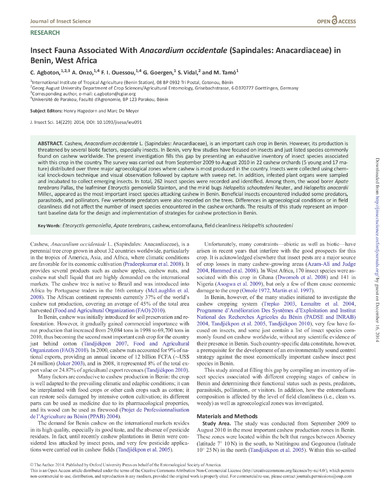Insect fauna associated with Anacardium occidentale (Sapindales: Anacardiaceae) in Benin, West Africa
Abstract
Cashew, Anacardium occidentale L. (Sapindales: Anacardiaceae), is an important cash crop in Benin. However, its production is threatened by several biotic factors, especially insects. In Benin, very few studies have focused on insects and just listed species commonly found on cashew worldwide. The present investigation fills this gap by presenting an exhaustive inventory of insect species associated with this crop in the country. The survey was carried out from September 2009 to August 2010 in 22 cashew orchards (5 young and 17 mature) distributed over three major agroecological zones where cashew is most produced in the country. Insects were collected using chemical knock-down technique and visual observation followed by capture with sweep net. In addition, infested plant organs were sampled and incubated to collect emerging insects. In total, 262 insect species were recorded and identified. Among them, the wood borer Apate terebrans Pallas, the leafminer Eteoryctis gemoniella Stainton, and the mirid bugs Helopeltis schoutedeni Reuter., and Helopeltis anacardii Miller., appeared as the most important insect species attacking cashew in Benin. Beneficial insects encountered included some predators, parasitoids, and pollinators. Few vertebrate predators were also recorded on the trees. Differences in agroecological conditions or in field cleanliness did not affect the number of insect species encountered in the cashew orchards. The results of this study represent an important baseline data for the design and implementation of strategies for cashew protection in Benin.

